Research Article
Nurses Knowledge Regarding Prevention of Surgical Site Infection in Private Tertiary Care Hospital, Peshawar, Pakistan.
6483
Views & Citations5483
Likes & Shares
Objective: The aim of this study was to identify level of nurse’s knowledge about prevention of surgical site infection (SSIs) in private tertiary care hospital.
Methodology: A descriptive cross-sectional study design was used in a private tertiary care hospital Peshawar, KPK. Participants were selected from surgical wards by using convenient sampling technique. The data was collected through adopted and modified structure questionnaire. Data was analyzed through SPSS 21 version. Chi-square test was applied for association among different variables.
Results: The study consisted of 70 participants including 41.40% male and 58.60% female. The overall knowledge of the participants was divided into three categories that was poor, average and good knowledge. It was revealed from the results that 50% of the participants had an average level of knowledge. The mean score was 13.83 with standard deviation of 2.6. Chi-square test was applied to check association between knowledge and educational level which was significant with the P-value of 0.005.
Conclusion: Surgical site infection or post-operative wound infection is one of the most common infections in health care. Majority of the participant (50.00%) had an average level of knowledge regarding prevention SSIs. This indicates that nurses need further training about SSIs.
Keywords: Nurses, Infection, Surgical site, Wound
BACKGROUND
Surgical site infections (SSI) or post-operative wound infection is one of the most common causes of health care associated infection. It is also one of the most important complications of a surgical procedure [1]. These infections can range from a simple incision site abscess with purulent discharge to a complex infection that may contribute to a life- threatening condition and possible morbidity and mortality. The centers for disease control and prevention (CDC) definitions for surveillance of surgical site infections consider 3 classes of wound infections: superficial, deep incisional SSI, and organ/space SSIs [2]. It is an infection which occurs within 30 days after a surgical procedure or up to one year in those surgical patients in which implant has been placed in their organ [3]. Certain factors, intrinsic and extrinsic, are known to be responsible for surgical site infections. Intrinsic factors include life style such as advanced age, malnutrition, metabolic diseases, smoking, obesity, hypoxia, immune-suppression, and length of preoperative stay. Extrinsic factors consist application of skin antiseptics, pre-operative shaving, antibiotic prophylaxis, and pre-operative skin preparation, inadequate sterilization of instruments, surgical drains, surgical hand’s scrubs, and dressing techniques [1]. Incidence of SSIs may vary from hospital to hospital in different countries. Developed countries such as the USA, United Kingdom (UK), and Sweden have lower incidence of SSIs ranging for 2% to 6.4% where as in developing countries such as Pakistan, India, Nepal, Turkey, and Iran, the incidence of SSIs is higher ranging from 5.5% to 25% [4]. Incidence rate of surgical site infection in Pakistan is also documented as high. A study conducted in Nawab Shah in 2010 in which the rate of surgical site infection was found as 9.3%.
In addition, another study points out that the incidence rate of surgical site infection was 8.6% [3]. The study revealed that nurses reported a low level of knowledge and practice regarding the prevention of surgical site infection. This indicates that nurses working in the surgical related wards lack some knowledge of surgical site infection prevention [5]. Another study was conducted by Teshager [6] on 423 nurses from 2 hospitals to assess nurses' knowledge and practice. The results of this study pointed out that only 40.7% of nurses were knowledgeable regarding surgical sites infection and only (48.7%) nurses had good practice on surgical site care, according to the study conducted by Alabdulrazaq that level of knowledge regarding prevention of the surgical site infection to be low and insufficient. Only 25.4% and 18.3% participants were knowledgeable with the mean score 16.01, 14.30 respectively. A study was done by Dhakal, Angadi, and Lopchan [7] to find out the nurses' knowledge regarding SSIs. The analysis of the data revealed that, 62.5 % respondents had high knowledge, 37.5% had an average knowledge while none of the respondents had low level of knowledge about SSIs. Another study was conducted on the nurses regarding the prevention of surgical site infection. Findings, of the study highlight that the nurses had poor level of knowledge and good level of practices regarding the prevention of surgical site infection [8]. The Purpose of this study was to identify the level of nurse’s knowledge about prevention of surgical site infection (SSIs) in private tertiary care hospitals.
METHODOLOGY
Research design
Descriptive Cross-sectional study design was used to get information on nurses’ level of knowledge regarding prevention of surgical site infection. Cross sectional design is best to use when the researcher is interested to gather information at one point in time; it provides a Snapshot of a population [9].
Population and sampling technique
Population for this study was registered nurses who were working in surgical wards of Private Tertiary Care hospital Peshawar. The convenient sampling technique was used for this study. This technique was used due to limited time.
Sample size
Sample size was 70 for this study as calculated by Rao soft. Total population was 85with the margin of error 0.5% with confidence interval 95%.
Data collection tool
For the data collection a modified structured questionnaire (appendix B) was adopted by the corresponding author [4] to assess the following:
- Nurse’s socio-demographic characteristics such as their age, gender, qualification, and working experience.
- Participants' knowledge was assessed through 20 multiple choice questions.
Setting
This research study was conducted in the surgical wards of a private tertiary care hospital a representative for this study.
Ethical consideration
Written permission was obtained from the Chief Nurse of the hospital. Informed consent was distributed among participants of this research. Subjects were informed that they have a right to participate or not to participate, and explained that their information will be kept confidential. Permission was taken from corresponding author [4].
Inclusion criteria
All registered nurses having minimum one year of experience in surgical units.
Exclusion criteria
Data analysis
The collected data was analyzed through (SPSS) version 21. In descriptive study continuous variable, mean and standard deviation was calculated. While for categorical variable, frequency and percentage was used. Furthermore, Chi square test was applied for categorical variable association. The knowledge of the participants was divided into three categories. Those who scored from 1-10 was considered poor, from 11-15 was average, and from 16-20 was considered in a level of good knowledge (Table 1).
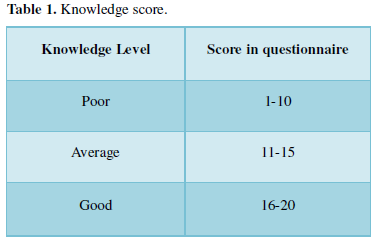
RESULTS
The study consisted of 70 participants, including 29 (41.4%) males and 41 (58.6%) females (Figure 1).
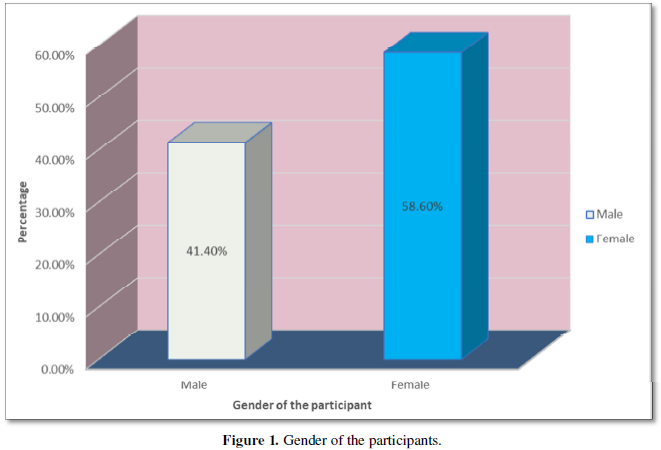
Numbers of participants from 20-25 years were 39 (55.7%), from 25-30 years were 25 (35.7%) and above 30 years were 6 (8.6%), (Figure 2). Only 31 (44.3%) of the respondents were diploma holders and 39 (55.7%) had done BSN (Table 2). Experience of the participants from 1-3 years were 55 (78.6%), 3-6 years 11 (15.7%), 6-9 years 1 (1.4%), and above 9 years 3 (4.3%) were calculated (Table 3).
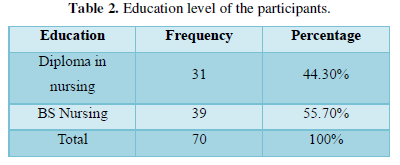
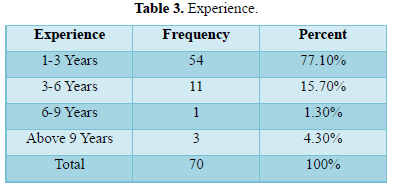
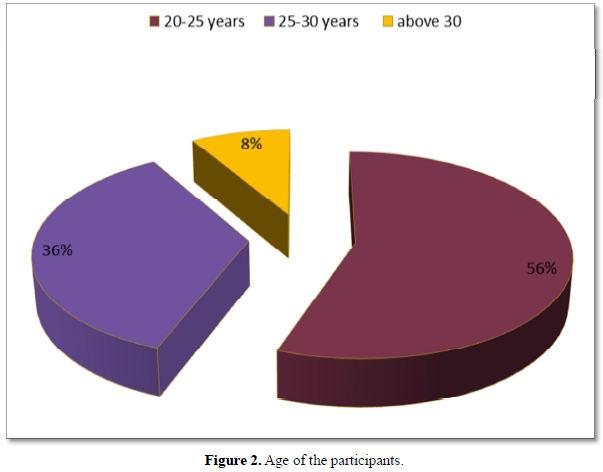
Participants of the study who were working in orthopedic surgical ward were 6 (8.6%), general surgical ward were 19 (27.1%), cardiac surgical ward were 13 (18.6%), and surgical intensive care unit (ICUs) were 32 (45.7%) (Figure 3).
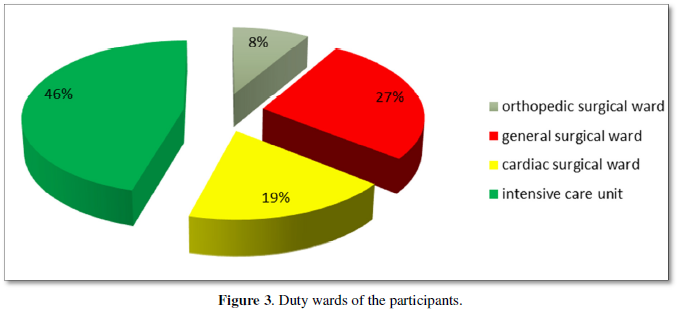
Knowledge of the staff nurses was calculated in percentage. The result of the study showed that among the participants 22 (31.4%) had good, 35 (50.0%) had an average, 13 (18.6%) had low level of knowledge regarding surgical site infection (Figure 4).
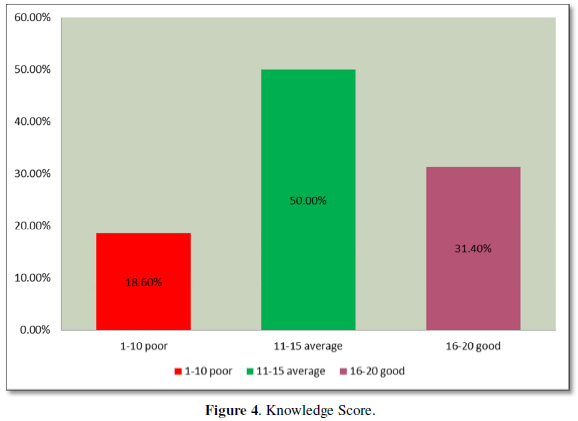

Result of the study showed the individual score in questionnaire with the Mean of =13.83 and Std. Dev =2. 659. Furthermore, chi-square test was applied to check the association among variable and knowledge; only there was an association between knowledge and education level of participants with p value of 0.005 in the result (Figure 5) (Table 5).
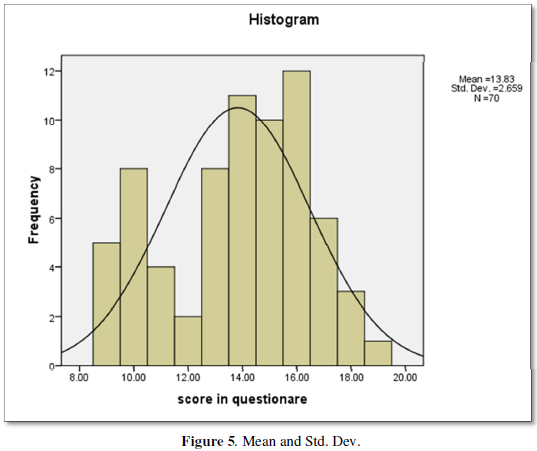
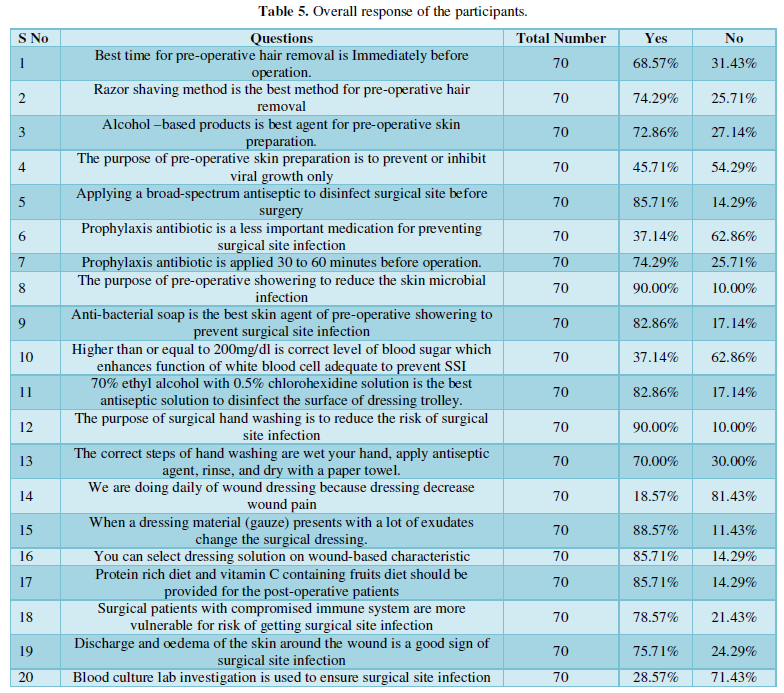


DISCUSSION
Surgical site infection is an infection associated with health care worldwide that represents a burden on patients and health systems. Nursing is an integral part of the health care system. Nurses' knowledge is essential to patient’s care. Their knowledge plays an important role in controlling these infections. Several studies were found in different countries of the world. According to a study conducted in Saudi Arabia to find out the knowledge and practice towards the prevention of surgical site infection between two hospitals. Finding of study highlights that the level of knowledge regarding the prevention of surgical site infection to be low and insufficient [2]. In contrast, the current study results reported average level of knowledge about prevention of
surgical site infection. It might be due to qualification of nurses, as majority of staff nurses had qualifications of BSN while only 44.30% had done diploma in nursing, this might affect nurse’s knowledge. The analysis of the data revealed that, 62.5 % respondents had good knowledge, 37.5% had an average knowledge whereas none of the respondents had low level of knowledge about SSIs [7]. Contrary, the current study showed that only 31.40% had good knowledge, 50.00%had an average knowledge and 18.60% had low level of knowledge regarding SSIs. The current study highlighted an average level of knowledge regarding the prevention of surgical site infection. However, a study conducted by Sadia [8] point out that the nurses were reported to have a low level of knowledge and practice regarding the prevention of surgical site infection. This indicates that nurses working in the surgical related wards had inadequate knowledge of SSIs.
CONCLUSION
The study was conducted to assess knowledge about prevention surgical site infection among nurses in private tertiary care hospital Peshawar. Surgical site infections (SSI) or post-operative wound infection is one of the most common infections in health care. It is also one of the important complications of a surgical procedure. Being a health care professional, nurses should have enough knowledge about each aspect of the SSIs process. It is highlighted from the study that majority of the participant 50.00% had an average level of knowledge regarding prevention of SSIs. In this study, average knowledge level regarding prevention SSIs among nurses was observed. It is proved that nurses should need further education and training regarding prevention of SSIs.
- Famakinwa TT, Bello BG, Oyeniran YA, Okhiah O, Nwadike RN (2014) Knowledge and Practice of Post-Operative Wound Infection Prevention among Nurses. Int J Basic Appl Innov Res 3(1): 23-28.
- Elaf A, Hanadi A, AlHsaon M, Alsaigh S (2018) Knowledge and practice towards prevention of surgical site infection among healthcare professionals in Buraidah city, Saudi Arabia. Int J Med Health Res 4: 121-127.
- Malik ZI, Nawaz T, Tariq AM, Waqar SH, Zahid MA (2013) Surgical Site Infections in General Surgical Wards at a Tertiary Care Hospital. Pak J Med Res 52(4): 116-118.
- Sickder HK, Sae SW, Petpichetchian W (2014) Nurses’ Knowledge and Practice Regarding Prevention of Surgical Site Infection in Bangladesh. The 2nd International Conference on Humanities and Social Sciences
- Sadaf M, Inayat S, Afzal M, Hussain M (2018) Nurse’s knowledge and practice regarding prevention of surgical site infection at allied hospital Faisalabad. Int J Sci Eng Res 9(5): 351-369.
- Teshager FA, Engeda EH, Worku WZ (2015) Knowledge, Practice, and Wounds Australia Standards for wound prevention and management, 3rd Osborne Park, WA: Cambridge Media.
- Dhakal B, Angadi S, Lopchan M (2016) Nurses' Knowledge and Practice of Aseptic Technique in the Operation Theatre at selected Hospitals of Bharatpur. Int Arch BioMed Clin Res 2(2): 32-34.
- Sadia S, Kousar R, Azhar M, Waqas A, Gilani SA (2017) Assessment of Nurses’ Knowledge and Practices Regarding Prevention of Surgical Site Infection. Saudi J Med Pharm Sci 3: 585-595.
- Seltzer J, McGrow K, Horsman A, Korniewez DM (2002) Awareness of surgical site Infections for advanced practice nurses. AACN Clin Issues 13(3): 398-409.
QUICK LINKS
- SUBMIT MANUSCRIPT
- RECOMMEND THE JOURNAL
-
SUBSCRIBE FOR ALERTS
RELATED JOURNALS
- International Journal of Internal Medicine and Geriatrics (ISSN: 2689-7687)
- International Journal of Radiography Imaging & Radiation Therapy (ISSN:2642-0392)
- Chemotherapy Research Journal (ISSN:2642-0236)
- Journal of Oral Health and Dentistry (ISSN: 2638-499X)
- Archive of Obstetrics Gynecology and Reproductive Medicine (ISSN:2640-2297)
- Journal of Ageing and Restorative Medicine (ISSN:2637-7403)
- Journal of Allergy Research (ISSN:2642-326X)







